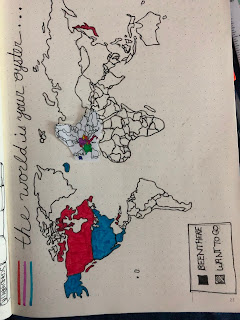A Reflection and Review of Ryder Carroll's "The Bullet Journal Method" & My Year Bullet Journalling
Something you guys may not know about me is that last year, as of May 2019, I started to take up bullet journalling, at Olga’s suggestion that I might like it as I love organization techniques, and any excuse to make practical art. On a whim, I purchased a Leuchturm 1919 dotted notebook, and began to search the internet for examples of this system in action. After watching a lot of YouTubers (BuJo YouTubers, as they’re called), and reading through a selection of subreddits, I began to structure a system for myself using the Bullet Journal Method.
My early spreads weren’t as great as I would’ve liked, and heavily based off of themes or spreads I found on Pinterest or YouTube. I liked how I was able to relax while drawing them however, and orient them to my own schedules and routines. At the time my first spreads were created, I was beginning to start research on my MRP which I would later go to defend in August. Now, though, this old blue notebook is going to be finished as of this week, and I get to move onto my second bullet journal, which I expect will chronicle up to August of this year.
So why am I writing this now? Well, since my first bullet journalling experience draws to a close, I’ve also gotten the opportunity to read Ryder Carroll’s book (the original creator of the Bullet Journal Method), self-titled “The Bullet Journal Method”. Since I only got this book as of December, much of my routine was self-learned or adapted from other bullet-journallers. Now, going into my second journal and having read the book, I’ve adapted Carroll’s original suggestions of the method into the ones that I feel already work for me, and this review, I hope, is a mix of both reviewing the book, and reflecting on my last year of bullet journalling as a newbie.
So, what is the Ryder Carroll’s “The Bullet Journal Method” about? Taken from GoodReads:
For years Ryder Carroll tried countless organizing systems, online and off, but none of them fit the way his mind worked. Out of sheer necessity, he developed a method called the Bullet Journal that helped him become consistently focused and effective. When he started sharing his system with friends who faced similar challenges, it went viral. Just a few years later, to his astonishment, Bullet Journaling is a global movement.
The Bullet Journal Method is about much more than organizing your notes and to-do lists. It's about what Carroll calls "intentional living:" weeding out distractions and focusing your time and energy in pursuit of what's truly meaningful, in both your work and your personal life. It's about spending more time with what you care about, by working on fewer things. His new book shows you how to...
• Track the past: Using nothing more than a pen and paper, create a clear and comprehensive record of your thoughts.
• Order the present: Find daily calm by tackling your to-do list in a more mindful, systematic, and productive way.
• Design the future: Transform your vague curiosities into meaningful goals, and then break those goals into manageable action steps that lead to big change.
Carroll wrote this book for frustrated list-makers, overwhelmed multitaskers, and creatives who need some structure. Whether you've used a Bullet Journal for years or have never seen one before, The Bullet Journal Method will help you go from passenger to pilot of your own life.
The bullet journal method is really quite ingenious while at the same time, obvious. It’s about putting everything in one place. The Bullet Journal acts as a scrapbook, daily planner, monthly planner, journal, or project-planning notebook, with a clean, easy-to-read system indexing different topics, pages, and projects. The key of it is: make it work for you. Carroll offers the guide and the bare basics, but you can modify or change it to fit your lifestyle and what works for you.
For me, my bullet journal primarily was a daily planner, but it also acted as a scrapbook for events, a way to rough draft my weekly reviews for this blog, a place to practically design and create art that I could use and incorporate into my daily life, recipe book, as well as monthly overviews to plan my next few months out and how I would reach goals for my various research projects.
For my second spread, I plan to make this more goal-based, incorporating the original suggestions and structure Carroll writes— including making a mental inventory of needs, wants, and musts, working out a yearly overview of how to achieve these goals in small manageable steps, and, something that is really important to me— more journalling, or what Carroll describes as “acts of daily reflection”. These are two periods between 5-15 minutes that you take each day to reflect and write down a record of how you’re feeling or doing. That way, you can see how your moods have shifted, or record any “why’s” of why you may be feeling a certain way, or want to achieve a certain goal. The key here is that you can make any spread or project spread that you want, so long as you understand it’s meaning or, why you’re doing it.
As an example, one thing I’m incorporating into my second journal is a mood tracker because I want to see if there’s a trend (in tandem with my journalling sessions) as to why I may be feeling negatively or be hesitant to change. It’s tied to one of my goals, which is to overall be more independent, more aware of myself, and be more emotionally mature and overall, happy with myself (right now I’m not as I’m fighting the plague…which I call the stomach flu).
Sideways so you can see the whole thing. But my newer spread's theme for that month will be Star-Crossed Myth themed!
Honestly, that’s one of the things that I liked most about Ryder Carroll’s book. You don’t have to be a newbie to the method, you can also be an experienced journalist coming back to the basics or to see an example of how other ways of journalling this method can be done. The book not only explains first, the theory of the method and then how to practically apply it, but also has pictures and examples of what he means— including examples of goal breakdowns and “collections” (a series of pages in a journal for meaningful projects) and how to properly break down goals into small, manageable steps to achieve them.
You don’t need a lot of fancy supplies either— if you look up bullet journal spreads you’ll see fancy pieces of art, and my spreads too, tend to favor that way as well. You don’t have to, all you need is a book and a pen to bullet journal and it can be as basic as you need it to be, so long as the system is tangible and works for you so that you’ll keep up with it. I’ll link some resources down below if this interests you.
The prose of the book and it’s organization is nice too, first describing why a certain system or heading is used in the bullet journal method before Carroll shows you a way to do it. You can read the whole book or skip between parts for reference on a specific section. I’ve been dog-earring pages or adding sticky notes as I read along so I can easily find certain sections later.
Having done this, now I have started setting up collections in my new bullet journal, and started a new legend for different aspects of my daily logs such as events versus tasks.
My Rating
More than that, Ryder Carroll’s book has really helped me to not only learn a few things that I couldn’t about the bullet journal method from videos online, but also to refine my method and the theory behind why we do these things as part of the method. I would really recommend the book if you’re interested in bullet journalling yourself, or just looking for a method that’s easy to take accountability for and adaptable to your own situations. It’s not a tough convoluted method to understand, nor does it cost a lot.
My Rating: ⭐⭐⭐⭐⭐ (5 stars)
~Meghan













Comments
Post a Comment